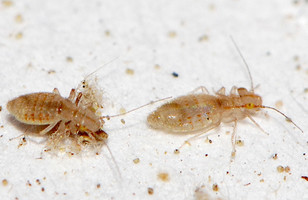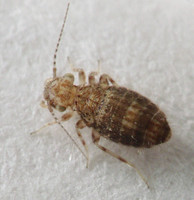Trogiidae
Emilie Bess and Kevin P. JohnsonIntroduction
The family Trogiidae includes 7 genera and about 50 species distributed worldwide. Seven species from four genera are known from North America. Most of the North American trogiids species have been collected in homes or stored food products.
Characteristics
Synapomophy
- Wings are greatly reduced and always veinless, sometimes absent.
General Characters
- Head:
- Antennae have more that 20 segments without ringed sculpturing (annulations).
- Ocelli are absent.
- Legs: Tarsi have 3 segments.
- Wings: Most species have reduced wings without veins, but wings are rarely absent.
- Male: Phallosome is open anteriorly with anteriorly diverging arms.
- Female:
- Paraproct has an anal spine.
- Gonapophyses are reduced:
- Dorsal valve is small or absent.
- Ventral valve is usually absent.
- External valve is elongate and hairy.
- Eggs are laid singly and are not covered in any way.
Discussion of Phylogenetic Relationships
The monophyly of family Trogiidae is supported by the form of the wings, which are greatly reduced and always veinless, sometimes absent. Molecular analysis including genera Cerobasis, Lepinotus, and Trogium also supports the monophyly of the family (18S & Histone3 nDNA, 16S rDNA; Yoshizawa et al. 2006).
References
Lienhard, C. and C.N. Smithers. 2002. Psocoptera (Insecta) World Catalogue and Bibliography. Muséum d'Histoire Naturelle, Geneva, Switzerland.
Mockford, E.L. 1993. North American Psocoptera (Insecta). Gainesville, Florida: Sandhill Crane Press.
Smithers, C.N. 1996. Psocoptera. Pp. 1-80, 363-372 (Index) in Wells A. (ed.) Zoological Catalogue of Australia. Vol. 26. Psocoptera, Phthiraptera, Thysanoptera. Melbourne: CSIRO Publishing, Australia.
Smithers, C.N. 1972. The classification and phylogeny of the Psocoptera. Memoirs of the Australian Museum 14: 1–349.
Yoshizawa, K., C. Lienhard, and K.P. Johnson. 2006. Molecular systematics of the suborder Trogiomorpha (Insecta: Psocodea: ‘Psocoptera’). Zoological Journal of the Linnean Society 146: 287–299.
Title Illustrations

| Scientific Name | Trogium pulsatorium |
|---|---|
| Location | Baiting Hollow, Suffolk County, New York, USA |
| Comments | The one on the left has been eating (I think eating) a pile of what looks like insect parts for the last 10 minutes. He has just chased off the intruder on the right. |
| Specimen Condition | Live Specimen |
| Identified By | Edward Mockford |
| Copyright | © 2009 |
| Scientific Name | Cerobasis |
|---|---|
| Location | San Pedro, Los Angeles County, California, USA |
| Size | 1.84 mm |
| Source | Photo#50137 |
| Source Collection | BugGuide.Net |
| Image Use |
 This media file is licensed under the Creative Commons Attribution-NonCommercial-NoDerivs License - Version 1.0. This media file is licensed under the Creative Commons Attribution-NonCommercial-NoDerivs License - Version 1.0.
|
| Copyright | © David Ellsworth |
About This Page
Emilie Bess

Illinois Natural History Survey, Champaign, Illinois, USA
Kevin P. Johnson

Illinois Natural History Survey, Champaign, Illinois, USA
Correspondence regarding this page should be directed to Emilie Bess at and Kevin P. Johnson at
Page copyright © 2009 Emilie Bess and Kevin P. Johnson
All Rights Reserved.
- First online 18 March 2009
- Content changed 18 March 2009
Citing this page:
Bess, Emilie and Kevin P. Johnson. 2009. Trogiidae. Version 18 March 2009 (under construction). http://tolweb.org/Trogiidae/14451/2009.03.18 in The Tree of Life Web Project, http://tolweb.org/










 Go to quick links
Go to quick search
Go to navigation for this section of the ToL site
Go to detailed links for the ToL site
Go to quick links
Go to quick search
Go to navigation for this section of the ToL site
Go to detailed links for the ToL site